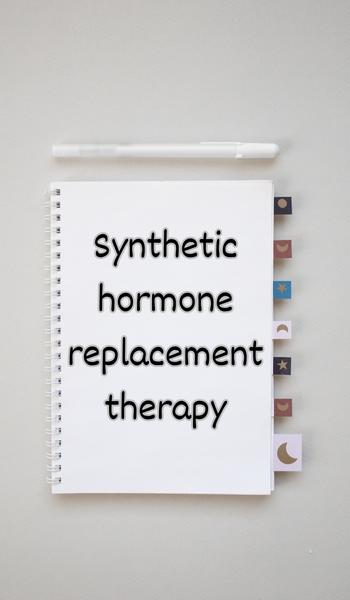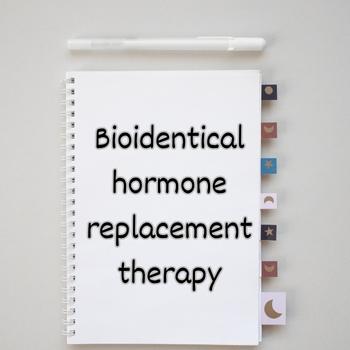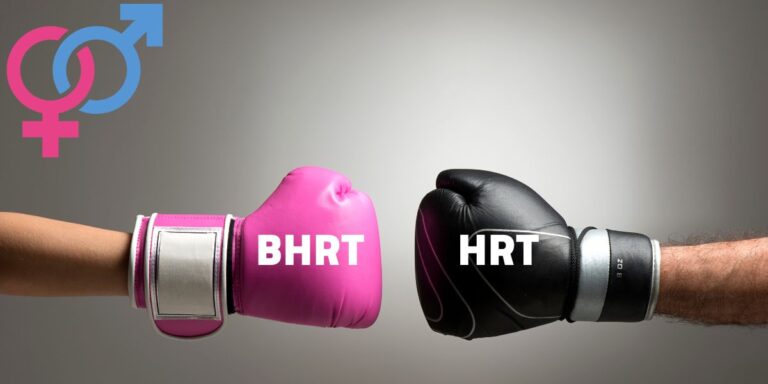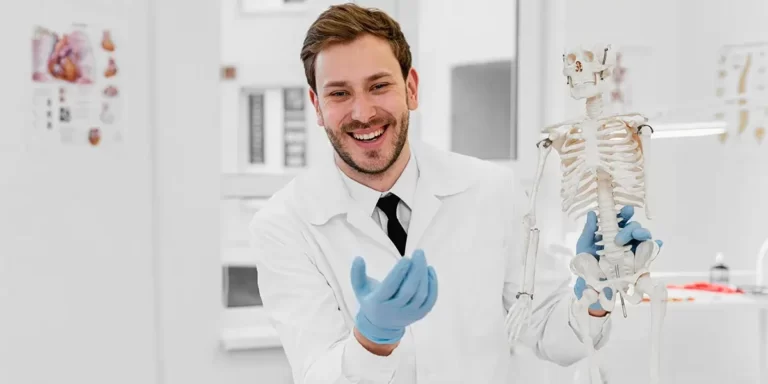Can you imagine what happens if a microgram of a chemical substance, naturally produced in your body, is missed?
A reduction in the naturally secreted amount of a hormone by just a fraction can turn your life upside down. That’s what normally happens after menopause. Hot flashes, painful intercourse, and sleep difficulties are a few to mention. Men also suffer from erectile dysfunction, low mood, and other problems with muscles and bones as a result of testosterone deficiency as they get older.
Fortunately, hormone replacement therapy can help patients restore their normal lifestyles. There are 2 hormone replacement therapy options; bioidentical hormone replacement therapy (BHRT) and synthetic hormone replacement therapy (HRT) that invites a BHRT vs HRT comparison, so let’s go deep into it.
What do female sex hormones normally do to women’s bodies?
Women have sex hormones that are naturally produced in their bodies. Females have 2 main sex hormones: estrogen and progesterone. Progesterone’s main function is to prepare the uterus lining to be ready to carry a baby if ovum fertilization occurs. This role continues during pregnancy, so the uterus lining grows day after day as the fetus grows.
While estrogen has many functions that are not limited to reproduction, here are some:
- Estrogen is responsible for women’s body shape; prominent breasts, curves, etc.
- Estrogen has a role in egg production (ovulation) and the thickening of the uterus lining.
- Estrogen maintains regular periods.
- Estrogen helps you enjoy sex as it lubricates your vagina, thickens its walls, and increases its elasticity.
- Estrogen boosts your concentration, bone mass, and skin elasticity.
After menopause, estrogen levels decrease, so women suffer from hot flashes, painful sex, osteoporosis, swinging moods, and even wrinkles on the face.
If you think you are suffering from any of these symptoms, press here so we can refer you to a physician.

Causes of sex hormones reduction
You may wonder why some people are in need of hormone therapy. It’s simply because their bodies don’t produce enough of this hormone. Sex hormones insufficiency is a normal state as we get older but there are many other reasons that cause this.
Causes of sex hormones deficiency in women
Low estrogen may indicate an underlying medical condition if it’s not related to menopause. Some of these conditions are:
- Premature menopause
- Eating disorders
- Genetic abnormalities
- Autoimmune diseases that affect the ovaries
- Treating cancer with chemotherapy or radiotherapy that affects the ovaries
- Surgical removal of one ovary or both
- Conditions affecting the pituitary gland as it secretes hormones that stimulate estrogen secretion
- Hypothalamic amenorrhea, which is a condition of no periods because of excessive exercise and insufficient nutrition
Each of these conditions has its specific line of treatment; your physician will help you diagnose your illness and decide the best line of treatment to do so
What is hormone replacement therapy?
Hormone replacement therapy is a medication given to overcome the symptoms associated with the reduction of different sex hormones. As we mentioned, there are 2 hormone replacement therapy options: bioidentical hormone replacement therapy (BHRT) and synthetic hormone replacement therapy (HRT).
The main difference between BHRT and HRT is the source of each of them. BHRT is extracted from plants, while HRT is from an animal source. The BHRT vs HRT comparison is discussed in detail in this article.
Synthetic Hormone Replacement Therapy (HRT)
For females, The first formula of traditional or synthetic hormone replacement therapy (HRT) was approved by the FDA at the beginning of the 20th century. There have been many trials until we reached the current formula, which contains both estrogen and progesterone. Estrogen alone is still used for females who have gone through surgical removal of their uterus.
HRT is made of pregnant animal urine, especially horse urine. Despite HRT not being laboratory-invented, it is called synthetic, as synthetic hormones are just hormones that are not chemically identical to human hormones. Different preparations of synthetic hormone replacement therapy (HRT) vary in doses and routes of administration, which means different benefits and side effects, but we will mention the most common ones.

Benefits of HRT
Studies have proven many favorable effects of HRT on postmenopausal women’s health. HRT can
- Treat postmenopausal symptoms like hot flashes.
- Prevent osteoporosis.
- Decrease the risk of colorectal cancer.
- Reduce depressive mood symptoms.
- Reduce the risk of developing diabetes and has a favorable effect on glucose and insulin metabolism.
- Improve lipid metabolism.
Side effects of HRT
As HRT doesn’t have the exact chemical structure of estrogen and progesterone, it has many side effects, including:
- Only alleviates the symptoms but does not completely cure them.
- Standard doses can’t be customized to match every patient’s needs.
- It’s thought that HRT increases the risk of developing cardiovascular disease, so it’s not suitable for patients who already have the risk factors for cardiovascular diseases or after 10 years of menopause.
- It increases the risk of gallbladder diseases, like stones.
- HRT increases the risk of developing breast, ovarian, and endometrial (uterus lining) cancers (a combination of both estrogen and progesterone doesn’t increase the risk of developing endometrial (uterus lining) cancer).
Your doctor will always weigh up all the treatment options available to decide which is best for you.
Bioidentical Hormone Replacement Therapy (BHRT)
When we are going to start a BHRT vs HRT comparison, the first point to be mentioned is the source. BHRT is derived from plants; it is then modified in the laboratory so its chemical structure is identical to that of human hormones. BHRT is a relatively new medicine; more studies are needed to know more about its benefits and side effects, but we will try to tell you what scientists have found so far.

Benefits of BHRT
The main benefit of BHRT is that it is a compounding drug, which means it can be tailored to cure each patient’s suffering. Patients with vaginal atrophy express improvement in different sexual functions when treated with compounded BHRT. BHRT can improve vaginal lubrication, arousal, and satisfaction.
Side effects of BHRT
There are no proven side effects of BHRT; more long-term studies are needed to assess if BHRT can prevent bone fractures or increase the chance of developing breast cancer, endometrial cancer, cardiovascular disease, or any other condition.
If you want to order prescribed compounding BHRT from our pharmacy or want a referral for a physician to describe it, Welltopia will always be here for your health and well-being.
Comparing BHRT and HRT: Key Differences
If we want to summarize the BHRT vs HRT comparison, it’s all about safety, clinical uses, and trying to mimic the natural female sex hormones.
BHRT mimics the natural hormones
One of the main factors in the BHRT vs HRT comparison is that HRT is not chemically similar to human hormones, which results in many side effects, but BHRT’s chemical structure is identical to human hormones, which makes it safer. There is another way that BHRT can mimic natural hormones. BHRT is a compounded drug, which means it can be customized to the patient’s needs, as all females do not have the same amount of hormones, and even the same person can have different amounts of specific hormones in different circumstances.
Clinical indications of BHRT and HRT
As a BHRT vs HRT comparison is invited, the most important thing is to check their main clinical indications.
There are not enough studies to prove that BHRT can’t treat postmenopausal symptoms like hot flashes and night sweats, but HRT can.
BHRT can treat symptoms related to vaginal atrophy, like painful sex and vaginal dryness.
Safety of BHRT and HRT
Regarding the BHRT vs HRT comparison, safety is the main concern here.
Unlike HRT, BHRT wasn’t found to develop any risk of cardiovascular diseases, which makes it safe for patients with cardiovascular diseases or cardiovascular disease risk factors.
HRT has a favorable effect on lipid metabolism, while BHRT shows no harmful effect on the lipid profile.
HRT improves both insulin & glucose metabolism and can even prevent diabetes mellitus, while BHRT has no side effects regarding glucose metabolism.
Patients on BHRT show normal endometrial (uterus lining) thickness, but further studies are needed to assess the risk of developing endometrial (uterus lining) cancer. Some formulas of HRT, specifically estrogen only, increase the risk of developing endometrial (uterus lining) cancer, and they should be avoided unless the patient has gone through uterine surgical removal.
For patients at risk of developing breast or ovarian cancer, it may be safer to consider BHRT, as HRT increases the risk of breast or ovarian cancer, but there are no studies to tell about the BHRT effect in this aspect.
Choosing the Right Hormone Therapy: Factors to Consider
Doctors always try their best to give you the best cure. There are many factors that they consider when you have a sex hormone deficiency; they actually make a BHRT vs HRT comparison along with other treatment options available. Some of the factors they take into consideration are:
- Patient age and onset of menopause
- Patient history: Your doctor will review your medical history, including your medication, previous surgeries, and family history.
- The nature and severity of the symptoms
Your doctor will discuss with you the treatment option he/she recommends, its benefits and drawbacks. You will need follow-up visits to make sure you are getting better.
Menopause is a normal state; you may suffer bothersome symptoms in the early years of it; but don’t worry your doctor will find you a way to treat them and you will restore your normal lifestyle. A lovely part of your life is about to start, so make sure you are filled with energy.

References
- Estrogen & skin
- Testosterone function
- History of HRT
- bioidentical hormone replacement therapy
- Hormone Replacement Therapy: Would it be possible to Replicate a Functional Ovary?
- Hormone replacement therapy in peri- and postmenopausal
- Safety and efficacy of compounded bioidentical hormone therapy (cBHT)
- Bioidentical Estrogen for Menopausal Depressive Symptoms







